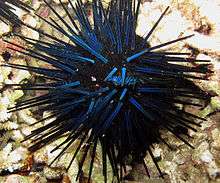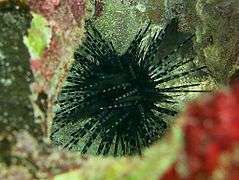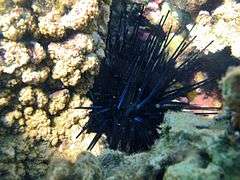Echinothrix diadema
| Diadema urchin | |
|---|---|
 | |
| Scientific classification | |
| Kingdom: | Animalia |
| Phylum: | Echinodermata |
| Class: | Echinoidea |
| Subclass: | Euechinoidea |
| Superorder: | Diadematacea |
| Order: | Diadematoida |
| Family: | Diadematidae |
| Genus: | Echinothrix |
| Species: | E. diadema |
| Binomial name | |
| Echinothrix diadema (Linnaeus, 1758)[1] | |
The diadema urchin or blue-black urchin (Echinothrix diadema) is a species of tropical sea urchin, member of the Diadematidae family.
Description and characteristics
Echinothrix diadema is a long spined urchin. With its spines, the typical diameter is 10–20 cm (3.9–7.9 in).[2] It is generally black or blue-black in colour, and always dark (the spines show a blue sheen in the light). The spines are closed at the tip; the anal sac is small and dark.
It differs from Echinothrix calamaris in that the spines are not banded, except in juveniles, and that its anal sac is small and hardly visible, and the spines show a blue sheen (whereas dark morphs of E. calamaris show a greenish tinge). Another similar species is Diadema setosum, which has longer spines and smaller test, the distinguishing feature being an orange ring around anal sac.
 Young individual
Young individual Older juvenile
Older juvenile Adult.
Adult.
Distribution and habitat
This species can be found throughout all the Indo-Pacific coral reefs, from the Red Sea to Hawaii. It is a shallow waters species, living between the surface and 10m deep, but can eventually be found down to 70m.
Behaviour
It is active at night, hiding in crevices or under rocks during the day.
It hosts commensal species like the shrimp Stegopontonia commensalis. Saron marmoratus stays close for protection, like many fish of the families Apogonidae (cardinalfish) and Centriscidae (razorfish and relatives).
References
- ↑ Kroh, Andreas (2013). A. Kroh & R. Mooi, eds. "Echinothrix diadema (Linnaeus, 1758)". World Echinoidea Database. World Register of Marine Species. Retrieved 2013-11-23.
- ↑ Florent's Guide To The Tropical Reefs: Blue-Black Urchin. Retrieved 12 September 2014.